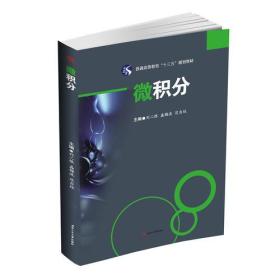
微积分
全新正版 极速发货
¥ 25.87 6.0折 ¥ 42.8 全新
库存4件
广东广州
认证卖家担保交易快速发货售后保障
作者毛纲源,周海婴 编著;米洪海,毛纲源 丛书主编
出版社华中科技大学出版社
ISBN9787568028394
出版时间2017-12
装帧平装
开本16开
定价42.8元
货号1201619671
上书时间2024-11-25
- 最新上架
商品详情
- 品相描述:全新
- 商品描述
-
作者简介
毛纲源,武汉理工大学资历教授,毕业于武汉大学,留校任教,后调入武汉工业大学(现合并为武汉理工大学)担任数学物理系系主任,在高校从事数学教学与科研工作40余年,除了出版多部专著(早在1998年,世界科技出版公司World Scientific Publishing Company就出版过他主编的线性代数Linear Algebra的英文教材)和发表数十篇专业论文外,还发表10余篇考研数学论文。主讲微积分、线性代数、概率论与数理统计等课程。理论功底深厚,教学经验丰富,思维独特。曾多次受邀在各地主讲考研数学,得到学员的广泛认可和一致好评:“知识渊博,讲解深入浅出,易于接受”“解题方法灵活,技巧独特,辅导针对性极强”“对考研数学的出题形式、考试重点难点了如指掌,上他的辅导班受益匪浅”。
周海婴,北京师范大学珠海分校副教授,毕业于南开大学,香港浸会大学数学博士,主讲微积分、概率论与数理统计、统计学、抽样技术等课程。在靠前外期刊发表中英文论文10余篇。
目录
Chapter 1 Functions(1)
1.1 Preliminary knowledge(1)
1.1.1 Inequalities and their properties(1)
1.1.2 Absolute value and its properties(5)
1.1.3 The range of variable(8)
1.2 Functions(10)
1.2.1 Concept of functions(10)
1.2.2 Features of a function(12)
1.2.3 Inverse functions(16)
1.2.4 Composite functions(19)
1.2.5 Elementary functions(20)
1.2.6 Non-elementary functions(30)
1.2.7 Implicit functions(33)
Exercise 1(33)
Chapter 2 Limit and Continuity(36)
2.1 Limit(36)
2.1.1 Definition of a sequence(36)
2.1.2 Descriptive definition of limit of a sequence(36)
2.1.3 Quantitative definition of limit of a sequence(38)
2.2 Limits of functions(39)
2.2.1 Definition of finite limits of functions as x→x0(39)
2.2.2 Definition of infinite limits of functions as x→x0(42)
2.2.3 Limits of functions as independent variable tending to infinity(44)
2.2.4 Left limit and right limit(47)
2.2.5 The properties of limits of functions(48)
2.2.6 Operation rules of limits(50)
2.2.7 Criteria of existence of limits and two important limits (54)
2.2.8 Infinitesimal, infinity and their basic properties(58)
2.2.9 Simple application of limit in economics(62)
2.3 Continuity of functions(64)
2.3.1 Continuity(64)
2.3.2 Discontinuous points of a function(68)
2.3.3 Operations and properties of continuous functions(69)
2.3.4 Continuity of elementary functions(72)
2.3.5 Continuity of the inverse functions(73)
2.3.6 Properties of continuous functions on closed interval(73)
Exercise 2(76)
Chapter 3 Derivative and differential(80)
3.1 Concept of derivative(80)
3.1.1 Introduction of derivative(80)
3.1.2 Definition of derivative(82)
3.1.3 Left-hand derivative and right-hand derivative(84)
3.1.4 The relationship between differentiability and continuity of functions(85)
3.1.5 Applying the definition of derivative to find derivatives(87)
3.1.6 Geometric interpretation of derivative(91)
3.2 Rules of finding derivatives(91)
3.2.1 Four arithmetic operation rules of derivatives(91)
3.2.2 Derivative rules of composite functions(93)
3.2.3 Derivative rules of inverse functions(95)
3.2.4 Derivative rules of implicit functions(96)
3.2.5 Derivative rules of function with parametric forms(97)
3.2.6 Some spe derivative rules(98)
3.2.7 Basic differentiation formulas(100)
3.2.8 Derivatives of higher order(102)
3.3 Differentials of functions(104)
3.3.1 Definition of differentials(104)
3.3.2 The equations of a tangent and a normal(107)
3.3.3 Formulas and operation rule of differentials(109)
3.3.4 Application of differentials in approximating values(111)
Exercise 3(112)
Chapter 4 The mean value theorems and application of derivatives(116)
4.1 The mean value theorems(116)
4.1.1 Rolle’s theorem(116)
4.1.2 Lagrange’s theorem(118)
4.1.3 Cauchy’s theorem(121)
4.2 L’Hospital’s rule(123)
4.2.1 Evaluating limits of indeterminate forms of the type 00(124)
4.2.2 Evaluating the limits of indeterminate forms of the type ∞∞(126)
4.2.3 Evaluating the limits of other indeterminate forms(127)
4.3 Taylor formula(129)
4.4 Discuss properties of functions by derivatives(136)
4.4.1 Monotonicity of functions(136)
4.4.2 Concavity and Convexity(140)
4.5 Extreme values(143)
4.6 Absolute maxima (minima) and its application(148)
4.6.1 Absolute maxima (minima)(148)
4.6.2 Applied problems of absolute maxima (minima)(150)
4.7 Graphing(152)
4.7.1 Asymptotes lines of curves(152)
4.7.2 Sophisticated graphing(154)
4.8 Application of derivatives in economics(158)
4.8.1 Marginal analysis(158)
4.8.2 Elasticity of function(164)
Exercise 4(169)
Chapter 5 Indefinite integrals(173)
5.1 Anti-derivative and indefinite integral(173)
5.1.1 Concept of anti-derivatives(173)
5.1.2 Concept of indefinite integrals(175)
5.2 Fundamental integral formulas(177)
5.3 Integral methods of substitution(180)
5.3.1 The first kind of substitution(180)
5.3.2 The second kind of substitution(185)
5.4 Integration by parts(189)
5.5 Evaluate indefinite integrals of some spe type(194)
5.5.1 Integrals of rational functions(194)
5.5.2 Integrals of irrational functions(198)
5.5.3 Integrals of trigonometric functions(199)
5.5.4 Integral of piecewise defined function(201)
Exercise 5(202)
Chapter 6 Definite integrals(205)
6.1 Definition of definite integrals(205)
6.1.1 Two examples for definite integrals(205)
6.1.2 Definition of definite integrals(207)
6.1.3 Geometric meaning of definite integrals(211)
6.2 Basic properties of definite integrals(212)
6.3 Fundamental theorem of calculus(219)
6.3.1 A function of upper limit of integral(219)
6.3.2 Newton-Leibniz formula(222)
6.4 Integration by substitution and by parts for definite integrals(224)
6.4.1 Integration by substitution for definite integrals(225)
6.4.2 Integration by parts for definite integrals(229)
6.5 Improper integrals(231)
6.5.1 Improper integrals on infinite intervals(231)
6.5.2 Improper integrals of unbounded functions(239)
6.6 Application of integrals(241)
6.6.1 Computing areas of plan figures(241)
6.6.2 Volume of a solid of revolution(245)
6.6.3 Some economic applications of integrals(247)
Exercise 6(249)
Answers to exercises(256)
Answers to exercise1(256)
Answers to exercise2(257)
Answers to exercise3(257)
Answers to exercise4(259)
Answers to exercise5(261)
Answers to exercise6(262)
内容摘要
本书采用学生易于接受的知识结构和英语表述方式,科学、系统地介绍了微积分(上册)中函数的概念、极限和连续、导数和微分、中值定理和导数的应用、不定积分和定积分等知识。强调通用性和适用性,兼顾优选性。本书起点低,难度坡度适中,语言简洁明了,不仅适用于课堂教学使用,同时也适用于自学自习。全书有关键词索引,习题按章配置,题量适中,题型全面,书后附有答案。 本书读者对象为高等院校理工、财经、医药、农林等专业大学生和教师,特别适合作为中外合作办学的靠前教育班的学生以及准备出国留学深造学子的参考书。
相关推荐
— 没有更多了 —






















以下为对购买帮助不大的评价